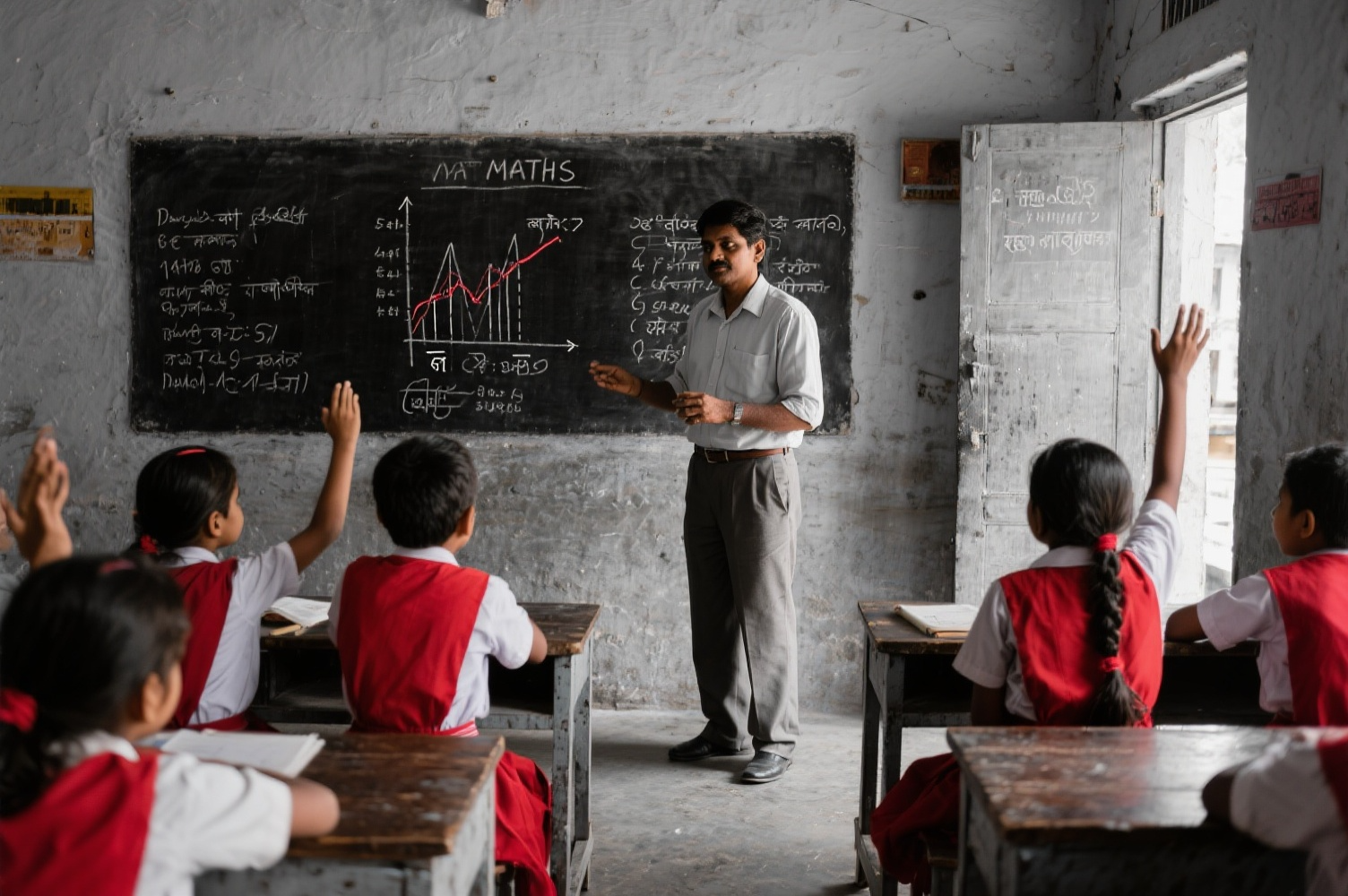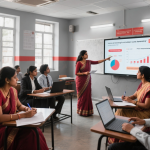- December 12, 2023
- by Educational Initiatives
- Blog
- 0 Comments
This article is a study in the educational achievement of girls and boys. Differences in student achievement were analysed using data from ASSET, ASER, TIMSS, and PISA from the past years. Read to find out more about how differently girls and boys through ages 8 to 16 score in English, Maths, and Science in India and internationally.
As the article is about identifying the gender gap between girls and boys observed using data collected from assessments, we will start with a short assessment of your perception of the gender gap.
Try and answer the following questions about students going to schools in urban India.
- What is the difference in performance between girls and boys in English tests?
- Girls score higher
- Boys score higher
- There may not be a significant difference.
- What is the difference in performance between girls and boys in Science/EVS tests?
- Girls score higher
- Boys score higher
- There may not be a significant difference.
- What is the difference in performance between girls and boys in Math tests?
- Girls score higher
- Boys score higher
- There may not be a significant difference.
- Will your answer to the above questions change for the following students?
- Girls and boys from rural India
- Girls and boys from countries more developed than India
- If there is an achievement difference between girls and boys, is it innate?
- Yes
- No
- I do not know!
The article may be able to help you find data to support or disprove what you have answered. So, read on.
About the four tests
ASSET [i]is a skill-based assessment offered by Educational Initiatives since 2001. In this article, we are going to analyse ASSET data for English, Maths and Science for grades 3 to 10. In India, almost 3 lakh students take ASSET tests once a year. More than half of these students are from metropolitan cities and above 80% of them are from urban areas.
ASER [ii](Annual Status of Education Report) is an annual survey conducted Pratham that captures the basic learning levels for each state and rural district in India. For our analysis, we are going to look at data from ASER 2018 for Basic Reading and Arithmetic for children of the age group 3 to 16 years.[iii] ASER 2018 tested children of all age groups on basic reading and arithmetic skills.
TIMSS [iv](Trends In International Mathematics And Science Study) is an international comparative assessments of student achievement in mathematics and science. TIMSS has monitored trends in mathematics and science achievement every four years, at the fourth and eighth grades. We have analysed data from the latest round of TIMSS with publicly available data [v], conducted in 2015 in 57 countries.
PISA [vi](Programme for International Student Assessment) is an international study conducted once in three years. PISA tests the skills and knowledge of 15-year-old across multiple countries in – reading, mathematics, and science. We have analysed data from the latest round of PISA with publicly available data[vii], conducted in 2018 in 79 countries.
Before we delve into the analysis and observations, some disclaimers!
You may have noticed that the data we have analysed from the four tests are not from the same year. Our aim for the analysis is to observe the gender gap (in girls and boys) by analysing the results of these four tests. It’s also important to note that the nature and purpose of the four tests are very different.
Now that we have got that out of the way, let us start with ASSET first!
ASSET
ASSET tests approximately 3 lakh students per year from grades 3 to 10 in English, Maths and Science. In the past three years, of the total participants, approximately 43% to 46% have been girls. In this analysis, the percentile score of the student will be used to measure their achievement instead of the raw score [viii]on the test.
In English, girls perform much better than boys. In Maths, boys perform slightly better than girls. In science too, boys perform better than girls but by a smaller margin (Chart 1).
Chart 1: ASSET – Overall Performance of Girls and Boys in English, Maths and Science (aggregated across grades)

Let us dig a little deeper and see what is happening at a grade level. To make things simpler, let us analyse student performance across all three years aggregated together. The student performance pattern year-on-year is consistent.
Girls perform much better than boys consistently across grades in English (Chart 2). In Maths, boys perform increasingly better than girls with grade. Although, the difference in performances between girls and boys in English is larger than in Maths. In Science, girls perform better in lower grades, and boys perform better in the higher grades.
Chart 2: ASSET – Performance of Girls and Boys in English, Maths and Science Across Grades

ASSET test takers are largely from urban areas, let us now compare our findings with student achievement in girls and boys in rural areas. For this, we look at ASER 2018.
ASER 2018
ASER 2018, has tested ~4 lakh students from the age group of 5 to 16 years in Basic Reading and Arithmetic.
In Basic Reading, girls perform better than boys in the 8 to 10 and 11 to 13 age groups (Chart 3). In the 14 to 16 age group, boys seem to have finally caught up to girls. In Basic Arithmetic, Boys perform better than girls in the 11 to 16 age group.
Chart 3: ASER 2018 – Girls and Boys in Basic Reading and Arithmetic

The finding that girls perform better than boys in English and boys perform better than girls in Maths seems to be broadly consistent in rural areas of India as well.
But is this trend unique to India? What does the achievement of girls and boys look like in other countries?
TIMSS
TIMSS 2015, has tested ~6 lakh students from grades 4 and 8 in Maths and Science. In 2015, of the total participants, approximately 49% to 50% have been girls. The average scaled score will be used to measure student achievement.
In Maths, boys and girls perform similarly in grade 4 and grade 8, girls score better. In Science, in both the grades girls score better (Chart 4). Some countries do not follow this overall trend (Table 5) across grades and subjects. For example, although in Maths grade 8, girls score a higher average scaled score compared to boys, in 15% of the participating countries boys score better compared to an 18% in which girls do.
Chart 4: TIMSS 2015: Student Achievement – Girls and Boys in Maths and Science Across Grades in TIMSS

Table 5: TIMSS 2015: Percentage of Countries with achievement differences in TIMSS

Now, let us look at data from PISA, another internationally conducted assessment.
PISA
PISA 2018 has tested ~6 lakh students of 15 years of age (grades 9/10) in Reading, Maths and Science. The average scaled score will be used to measure student achievement.
In Reading, girls outperform boys by a large margin. In Maths, boys perform better than girls by a small margin and in Science, girls are better by a small margin (Chart 6). In English, in all the participating countries girls perform better than boys. Some countries do not follow the overall trend (Table 7) across grades and subjects.
Chart 6: Percentage of Countries with achievement differences in TIMSS

Table 7: Percentage of Countries with achievement differences in PISA

While it seems like the pattern in the difference in performances of girls and boys in TIMSS and PISA is not consistent, it must be noted that the number of countries participating in TIMSS and PISA are different. For the countries that are common to both, we noticed that in both Science and Maths, the average achievement of girls/boys in TIMSS was strongly correlated with their average achievement in PISA. This means, that countries in which girls and boys have scored high/low in TIMSS also tend to score high/low in PISA.
Gender Gap in Student Achievement
Let us summarise what we have learnt so far. In English, across grades, girls perform much better than boys in India. This trend is found internationally in the Reading assessment of 15-year olds conducted by PISA across all participating countries. In Maths, boys perform better than girls in India across grades. In Science, boys perform better than girls in some grades by a small margin. Internationally, there is a divide in the performance of girls and boys in Maths and Science. From both TIMSS and PISA, we have learnt that there are countries in which girls perform better and countries in which boys do!
At this point, you may want to go back to the initial assessment. How did you fare? Were you surprised by any of the findings?
Now, let us talk about the last question from that assessment. There is an achievement difference between girls and boys, is it innate? Of course not, and there’s proof!
Several studies have shown that disruptive behaviour in school, whether students are school-oriented or oriented towards leisure time, feeling alienated from schools, adhering to more traditional gender images are some reasons that finally lead to lower educational achievement. [ix]
So how do we fix the gap?
Many countries have reduced their gender gap over the last decade and PISA has proof of that. In 36 of 64 countries, PISA 2018 report had noted that the gender gap in reading had narrowed between 2009 and 2018[x]. In 17 of those the reduced gender gap was due to an improvement in the performance of boys. In 43 out of 64 countries, the gender gap in Math in favour of boys did not change significantly between 2009 and 2018. In 5 countries, the gender gap in Math shrank due to an increase in the performance of girls.
Studying countries that have been able to narrow or close the gender gap in student performance over the years may help in identifying practices that help improve the achievement of both girls and boys.
References
[i] About ASSET: https://www.ei-india.com/asset
[ii] About ASER: http://www.asercentre.org/NGO/assessment/learning/education/outcomes/primary/reading/p/133.html
[iii] ASER 2018 Report: http://img.asercentre.org/docs/ASER%202018/Release%20Material/aserreport2018.pdf
[iv] About TIMSS: https://timssandpirls.bc.edu/timss-landing.html
[v] TIMSS 2015 data: https://timssandpirls.bc.edu/timss2015/
[vi] About PISA: https://www.oecd.org/pisa/
[vii] PISA 2018 data: https://www.oecd-ilibrary.org/education/pisa-2018-results-volume-ii_b5fd1b8f-en
[viii] Raw score – The actual score of the student on the test before being adjusted based on other test takers. For ASSET this is the sum of total correct answers
[ix] Andreas Hadjar, Sabine Krolak-Schwerdt, Karin Priem & Sabine Glock (2014) Gender and educational achievement, Educational Research, 56:2, 117-125, DOI: 10.1080/00131881.2014.898908
Link: https://www.tandfonline.com/doi/full/10.1080/00131881.2014.898908?scroll=top&needAccess=true
[x] PISA 2018 [Chapter: Girls’ and boys’ performance in PISA]: https://www.oecd-ilibrary.org/education/pisa-2018-results-volume-ii_f56f8c26-en



